This is how to make tofu easily at home with only soymilk, fresh lemon juice and water! Fresh, homemade tofu is so much better tasting than the store-bought stuff and super easy to make. Don’t worry, it doesn’t taste like lemons. And you won’t need anything special other than cheesecloth and maybe a food thermometer. Pin this for later.
Video Tutorial for How to Make Homemade Tofu
RELATED RECIPES
Important notes for making tofu successfully!
Store bought soymilk usually contains a bunch of additives so you won’t want to use that for this recipe. Use this homemade soymilk recipe to ensure great results. It does take time but it’s rather simple and easy. Otherwise, if you really want to try this and really cannot be making your own homemade soy milk, use store-bought at your own risk. Try brands that only contain soybeans, water and maybe salt. Also make sure it’s full fat and high in protein (at least 8 grams per cup).
By the way, this recipe makes “regular” style tofu; the firm kind that you can stir-fry without it breaking apart. Click here for how to make Silken Tofu, also known as smooth tofu.
Why make tofu at home?
Simply put, fresh tofu tastes best and what is fresher than homemade? Plus you can customize the firmness to your needs and even experiment with flavours. And once you learn the first time, you will have The Power of Tofu. A very powerful power😉
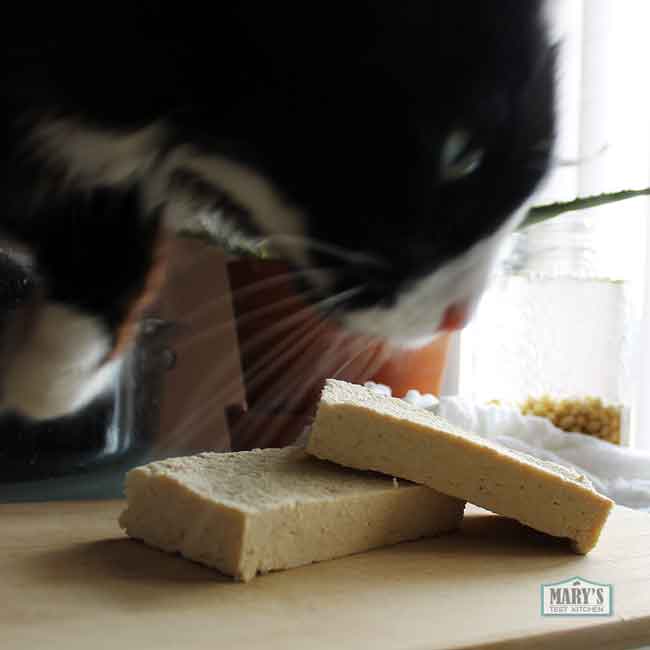
How to Make Tofu (the quick notes)
The process is:
- Make or procure good quality, high protein, full fat soy milk made from good quality soy beans
- Heat the soy milk up (160-170°F)
- Add a coagulant liquid (in this case, lemon and water) two times; once while stirring, once after a little bit
- Scoop the soy curds from the whey and form into a block
- Press the block of soy curds to compress to the right firmness
Sounds simple? It is! But with these few steps, it is important to get them right.
Why make tofu with lemon juice?
There are many traditional coagulants but you might be looking for a tofu coagulant substitute. I love to use lemon juice because it’s accessible! For most of us, buying fresh lemons or bottled lemon juice is easy and convenient from the grocery store.
Honestly, I came up with this when I wanted to try making tofu for the first time but didn’t have access to any traditional coagulants. And vinegar sounded like a bad option (spoiler! it’s not that bad haha).
Granted, this tofu made with lemons really isn’t the same as store-bought tofu made with traditional coagulants like calcium sulfate (gypsum) or magnesium chloride (nigari). Lemon-tofu comes out grainer (with smaller soy curds) while tofu made with gypsum or nigari comes out smoother and with larger curds.
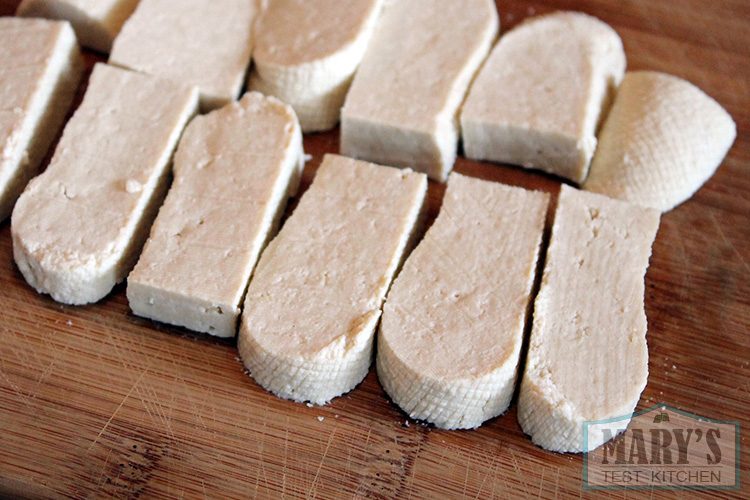
Check out this quick recipe for Chinese Five-Spice Tofu, one of my favourite ways to eat up fresh, homemade tofu.
Where to buy soybeans?
Here in Canada, I usually buy my soybeans from Superstore (so convenient!) or organic soybeans from Bulk Barn (less convenient for me but I like organic). You may be able to find them in supermarkets that serve a lot of Asian customers in particular, as well as health food and bulk food stores.
I’ve also found them online on Amazon and other E-tailers.
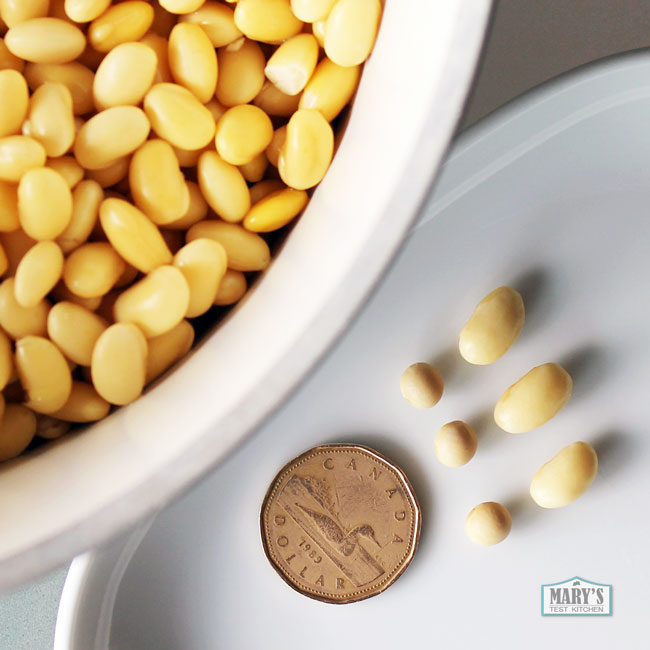
Is soy healthy though?
Hey! It’s just a BEAN. This legume has been consumed in China for centuries! Soy is one of the “5 Sacred Grains” and is one considered of the most healthful sources of complete protein. Check out this article from Dr. M Greger on the healthfulness of soy.
Ok, ok, I’m in no way an food expert, but I feel great eating tofu and drinking soy milk. For many years, I had stomach issues but after cutting out dairy and adding soy milk, I feel amazing. Sure, there may be other factors but my experience says it’s good! And also I may be biased as I am Chinese Canadian and grew up eating tofu.
All that said, I choose organic soybeans whenever I can (mainly not for health reasons tbh). And you might be interested to know, certified organic soybeans are also non-GMO.
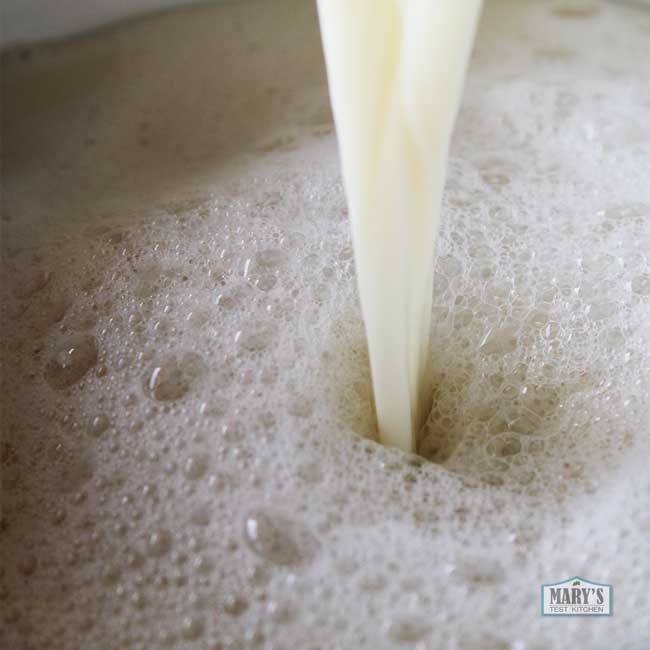
Do I need any special equipment to make tofu?
Not really! To make this tofu recipe, you probably have all the required equipment already. They include:
- a big pot, to fit at least 7 to 10 cups (need room in case of excess bubbling)
- a slotted spoon or similar ladle
- cheesecloth or thin woven fabric large enough to wrap the tofu and tie off the top
- a food thermometer
To make the homemade soy milk, you’ll also need a blender and nut milk bag. Jelly bags can also work but I find them not as durable as nut milk bags.
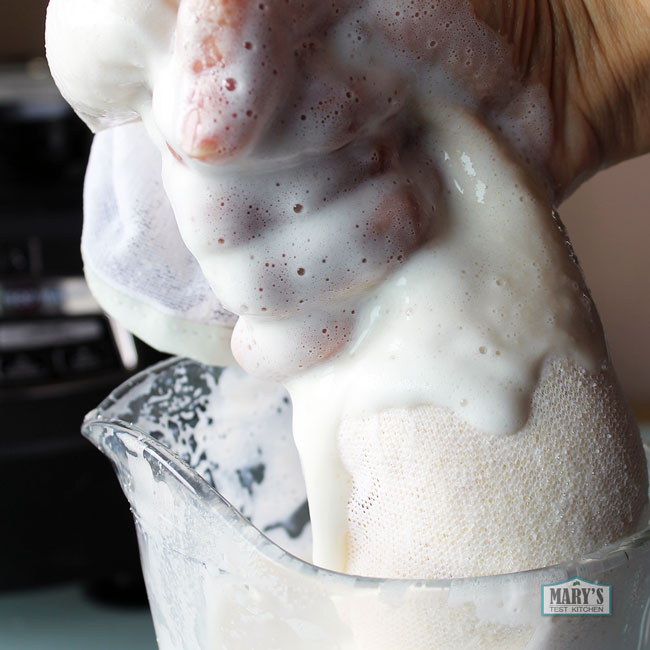
Why is your lemon-tofu so ugly? Can I use a mold?
I put off getting a mold because one of my personal mottos is “Use what you have!” That said, yes, my tofu is very ugly-looking! By all means, get a tofu-making mold. Over the years after posting this recipe (in 2014, now updating in 2021), I have three of these tofu-making mold kits that have the rectangular mold, a top to press down on the curds, and a nice reusable cloth liner too! All for TEN DOLLARS! 2014 would never.
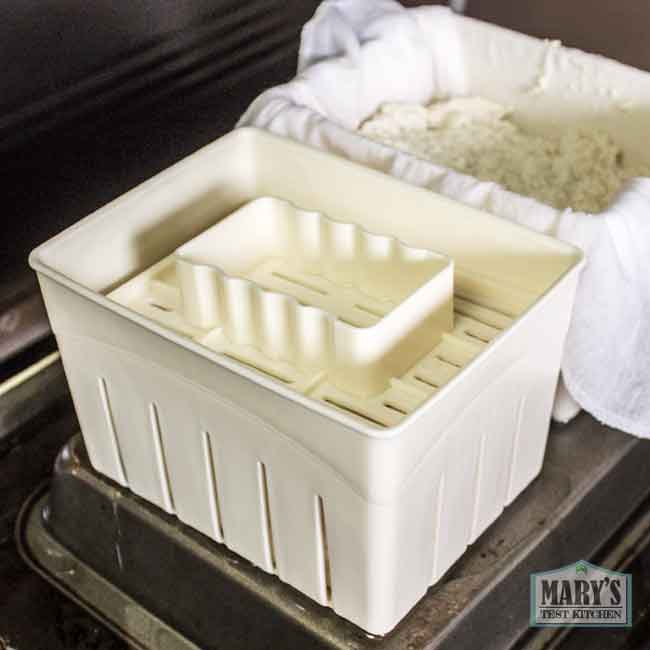
2023 update: I now sing the praises of THIS tofu press which has a spring-loaded lid to apply even pressure without needing to balance weights on top. The vented lid also makes it easy to pour away excess liquid.
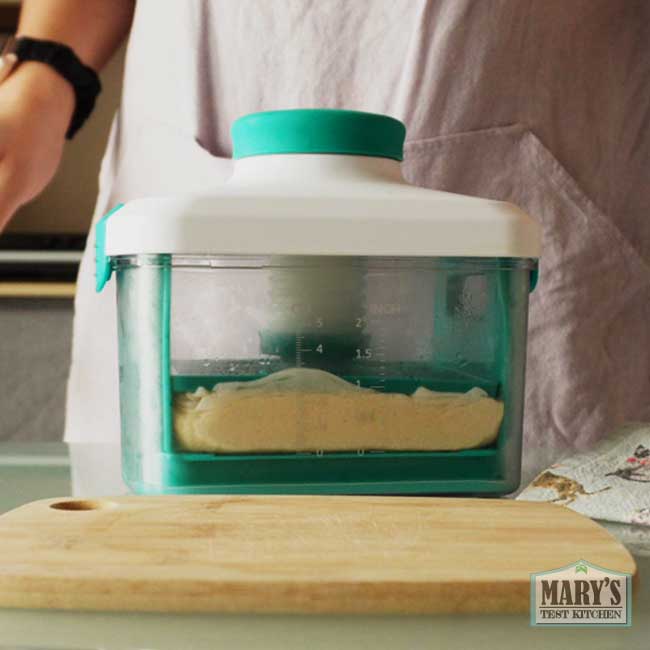
Tofu-making Troubleshooting
There are two main issues see people having when their tofu doesn’t turn out correctly. One, the soy milk doesn’t coagulate fully (or at all). The second issue is the tofu falling apart after pressing it. And then one issue I see a couple times a year, the soy milk does coagulate fully but you only got a tiny amount of tofu out of it! How frustrating! But don’t worry, I have your answers! You might not like them though 🤷♀️
Soy milk not coagulating fully (or at all)
If your soy milk has partly but not completely coagulated. Try adding just a few drops of lemon juice on the milky sections. Cover and let that sit. Did that work?
If not, you may just need to heat up your soy milk again. Avoid heating the milk and curds up too quickly so use medium heat to get the temperature back up to 160°F. Then turn off the heat, cover and it should finish coagulating.
If that doesn’t work, the problem may be your soy milk is not properly made for tofu-making. Even though there are many variations on how to make soy milk, my homemade soy milk recipe (original, not 2.0) is the best for consistently working for most recipe-followers.
If your store-bought soy milk isn’t coagulating, check the nutrition information. It should have at LEAST 8 grams of protein and minimal ingredients (soybeans, water, and not much else). That said, commercial brands vary so much (and there are so many out there) that I can’t tell you if yours will work or not. Some reader have reported plain Belsoy soy milk works for them while other readers reported that it didn’t work. So 🤷♀️
Homemade Tofu is falling apart!
This is mainly because of how you wrap and press the soy curds. You may notice in the video I’m pretty particular about how I wrap it. The cheesecloth has tension that keeps the shape and I try to keep the weight even. This will make the consistency of the tofu …well, consistent. And therefore, the tofu becomes a solid block. If you don’t wrap it well, some parts of your soy curds will get higher pressure than others and it will fall apart.
The other reason may be that you skipped or rushed the final step of shocking the tofu with cold water. The temperature change makes the soy curds shrink which helps the tofu become denser and the curds interlock with each other, helping it stay together. Make sure the tofu is nice and chilly all the way through before removing from the cold water bath.
That said, this homemade tofu is somewhat more delicate than store-bought. One thing that could help is using a tofu mold or a spring-loaded tofu press (my go-to these days).
My soy milk coagulated but I only got a tiny bit of tofu! What gives?
Did you use store-bought soy milk? Check the nutrition label. Some soy beverages only have 1 to 3 grams of protein! You want the one with the most protein because that’s what forms the soy curds that become tofu. I would look for brands with at least 8 grams per cup. And avoid anything that says “low-fat.”
When you make my homemade soy milk, using 200g (1 cup) of dry soy beans, you should get about 260g of tofu at the end of this process. If you did use homemade soy milk, you probably rushed either the blending step or the milking step.
You’ll know you haven’t blended your beans enough if your soy pulp is chunky. It should be really fine, pretty dry after milking, but sticks together like play-doh. I divide the batch into two parts when blending as my containers are not that big. And this takes about 30 seconds using my Vitamix on the highest setting or 2 minutes using my regular-powered Oster Blender on the Liquefy setting.
Similar to that, if your soy pulp is the right consistency but quite wet, you’ve got to squeeze it some more! Get all that protein and fat extracted out of those beans; put some elbow grease into it and strengthen your forearms at the same time!
What to do with your homemade tofu?
You can use your homemade tofu in any recipe that calls for firm tofu. Like this easy and delicious 5-spice tofu recipe.
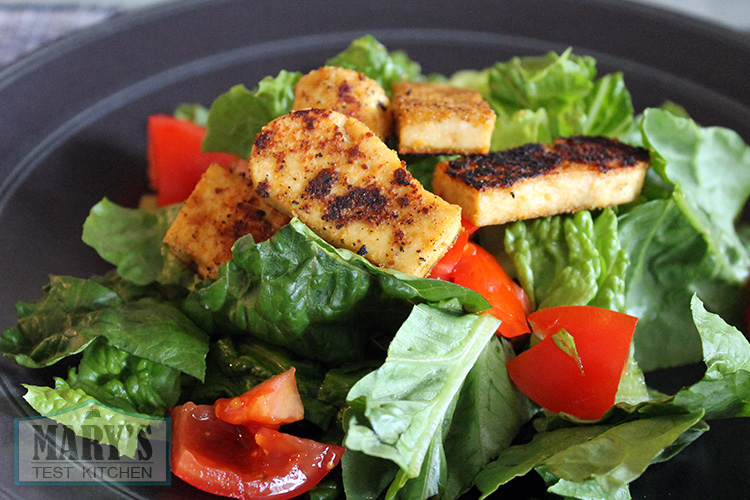
Printable recipe for DIY Tofu
How to Make Tofu (with just lemon + soy mlk)
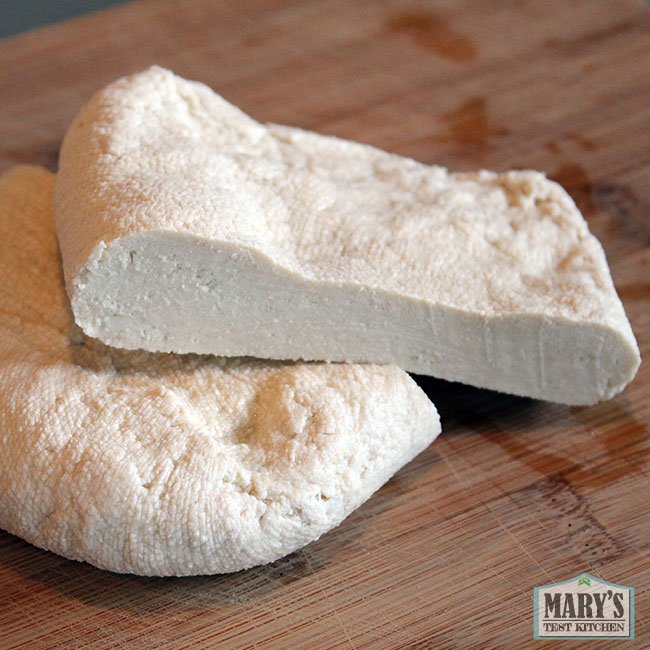
Make your own tofu at home with only soymilk, fresh lemon juice and water! Fresh, handmade tofu is so much better tasting than the store-bought stuff; milder and with a different bite. Plus it's super easy to make. And don't worry, it doesn't taste very lemon-y at all.
HOMEMADE soy milk made from THIS recipe is highly recommended. Many commercial soy milk brands will not coagulate properly. And some other soy milk recipes don't extract enough protein and fat to give you a good yield.
Ingredients
- 5 cups plain HOMEMADE soy milk (see description for recipe link)
coagulant:
- 1/2 cup water
- 1 1/2 tablespoons lemon juice (must be sour!)
Instructions
Heat and Coagulate
- Combine the water and lemon juice.
- Separately, heat the soymilk to 160-170°F (71-77°C) in a large pot. Be sure to stir constantly to keep the soymilk from burning on the bottom. If you don't have a thermometer, you can bring it just to a boil, then remove from heat and stir for a minute or two to cool.
- Remove the soymilk from heat and immediately stir half of the lemon mixture into the soymilk for 1 or 2 minutes with a wooden spoon or spatula. STOP immediately if the milk starts to thicken to avoid breaking the curds into small bits.
- Stand the spoon or spatula straight down into the milk to cause the spinning motion of the milk to stop.
- Add the rest of the lemon mixture and stir the spatula in a back and forth motion or a figure eight motion. The intent is to mix the lemon juice coagulant in thoroughly but gently. HOWEVER if the soymilk has already turned into solid curds, just spoon the lemon mixture over top.
- After a minute, the soymilk should start to separate and curds will begin to form. Stop stirring as soon as you see curds forming and cover the pot with a lid.
- Let sit for 15 minutes.
- Afterwards, the soymilk will have completely separated into bits of soybean curd and liquid. The liquid should be clear and yellowish. If it is still milky looking, it has not completely curdled. In that case, add a few drops of lemon juice to the milky liquid and stir gently.
Troubleshooting
- If your soy milk has not completely coagulated and you already tried adding a few more drops of lemon juice, you may need to heat up your soy milk again. Avoiding to heat up too quickly, use medium heat and get it back up to 160°F. Then turn off the heat, cover and it should finish coagulating. If that doesn't work, the problem may be your soy milk is not properly made for tofu-making.
Form the soy curds into tofu
- Prepare a colander or sieve lined with a few layers of cheesecloth over a bowl, or use a steamer pot.
- Scoop some soy curds with your slotted spoon or similar ladle and let excess water drain away before transferring to the cheesecloth.
- Carefully pull up the sides of the cloth to allow most of the water to drain out. Gather the sides of the cloth and twist at the top to squeeze out more water. *Wait a few minutes if the bundle is too hot to handle**
- Untwist the cloth and re-wrap the curds so that it forms a loaf shape.
- With the curds securely wrapped in the cheesecloth, place a couple pounds of weight on top. You want to press the curds evenly to force the water out. A cutting board with a few books on top would work well. Alternatively, use a tofu press device.
- Let sit for 15 to 30 minutes (longer time for firmer tofu)
- Place the wrapped tofu in a bowl of ice-cold water. This will help the tofu firm up further. After a few minutes, you can unwrap the tofu. Then let it sit in the water until completely chilled through. Afterwards, it's ready to use!
Storage
- Store fresh tofu in cold water, cover with a lid and refrigerate. Use as soon as possible; store for up to 5 days.
- If you're storing in the freezer, you don't need to keep it swimming in water. Just put in a freezer bag, squeeze out excess air and freeze. The texture will change to more spongy. Keep for up to 2 months.
Notes
Larger Batch?
While I recommend making this small batch for your first time making tofu, this recipe can be multiplied to make larger batches. This recipe makes about 260 grams (8.5 ounces) of firm tofu using 8 lbs of weight over 30 minutes. The weight of your finished product will depend on how much water is pressed from your tofu.
Can I use store-bought soy milk?
I don't recommend it only because so many people have reported failing with commercially available soy milk. It seems many soy milk brands include additives so you won’t want to use that for this recipe. In fact, these additives are sometimes added specifically to prevent curdling which is exactly the opposite of what we're trying to do. Use homemade soymilk or brands that only contain soybeans, water and maybe salt. Additionally look for a high protein and fat content.
Can I use almond/oat/cashew/other types of plant-milks?
No; not with this method. Only soy milk has enough protein to produce the amount of curds that you need to produce tofu.
What do you mean the lemon juice must be sour?
Sourness indicates the pH level is acidic enough to curdle the soy milk. Some lemons are not sour (aka sweet lemons) and the juice will not curdle the soy milk.
Nutrition Information:
Yield:
4Serving Size:
1/4 of recipeAmount Per Serving: Calories: 126Total Fat: 5gSaturated Fat: 1gTrans Fat: 0gUnsaturated Fat: 0gCholesterol: 0mgSodium: 151mgCarbohydrates: 10gFiber: 1gSugar: 8gProtein: 9g
Nutritional Information automatically calculated by a plugin and may not be correct.
-
[…] of cheesecloth. You can flavour it with your choice of sweetener or use this plain soy milk to make your own tofu or cultured […]
Leave a Comment

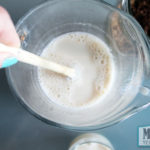

Hi Mary, I love your recipes, especially your non dairy cheeses. I just started following you in my RSS Feed Reader and get excited to see what you have shared every time I see a new post. Just one little thing, you forgot to say what the 1 1/2 tbs (22ml) was for in your recipe. It is obviously lemon juice but people tend not to think before they type and you are bound to end up with people asking what the ingredient is that is missing. Cheers for a most excellent website and thank you for sharing all of your wonderful recipes.
Thank you so much, dearie! Both for your kind words AND for catching my mistake! I am so glad you noticed that. <3
I had no success with this. I used west soy organic unsweetened soy milk, ingredients just soybeans and water. I tried adding more lemon juice, waiting a lot longer and then straining under a weight wrapped in Muslim for about 6 hours. I pulled the very very soft tofu out to put it in very cold water and it fell apart. I’m not sure what went wrong, but I would not try this recipe again.
Hi Mary, I’ve been using your tofu recipe. Mine is not as solid looking as yours. It’s not bad but any tips? Mine is a little bit too crumbly.
Hi Mary,
I am sensitive to soy and also am looking to make tofu with lemon juice. Are there any other beans you can sub in for this recipe?
Hi Kyla,
The closest substitution would be fava beans. For that, make sure to include the starch settling step as in this recipe: https://www.marystestkitchen.com/high-protein-soy-free-tofu/
Cheers,
Mary
ccan an other organic GMO free non dairy milk be used? almond, hemp, coconut, sunflower
To be honest, I do not know. For almond, it’s a probably not. Almond milk doesn’t tend to curdle in the same way. I have heard that hemp milk will work though! Someone shared this recipe (http://blogs.kqed.org/bayareabites/2012/01/31/hemp-tofu/) with me and said it was not bad. I am going to try is ASAP so I’ll let you know when I do. Or if you try it first, please let me know! 🙂
I just made the soy milk and then made the tofu. It turned out great!!! and soooooo easy !! thanks – great videos 🙂 Now, I am moving on to the “sea burgers” using the okara from the milk. Can’t wait to try them
Oh yay!!!! Connie, that is so great to hear. I am so happy that you tried the recipe and that the video was useful for you. Please let me know how the sea burgers work out for you. <3 Thank you so much for commenting and letting me know about your results! 🙂
yumm I just bought a tofu maker set so I can’t wait to try it out
Hi,
I soaked soya bean for 10 hrs then granded, and then i strain the milk whi i boiled and added 3 small lemons juice added in water, it did not cuddled/caugultes (not breakup)then i added s1/2 tbs salt still didnt caugulted then added two more small lemons directs still didnt caugulated rather it is turning into thick liquid like starch why?
Regards
Hi dear, I cannot tell why your soy milk did not coagulate at first. What did it look like when you added the lemon juice?
Salt is not in the recipe here. Flavourings should only be added after you have separated the soy curds from the water.
Other than those things, here are some important points:
– the soy milk needs to be good quality. Well made soy milk is creamy and thick, the okara (soy bean pulp) will be fine and quite dry.
– the soy milk needs to be the correct temperature before coagulant is added. The best thing is to use a correctly calibrated thermometer.
– make sure the lemons you use are sour lemons. There are types of lemons which are sweet and not sour. Do not use those kinds.
I hope that helps! Good luck!
At which point will you get the okara from the soymilk and which stage will you get the tofu and the soymilk. Other recipe that I saw they had three recipes. The okara, tofu and the soymilk. Pls help me am confused
Okara is the pulp from straining the blended soy beans; the stuff leftover in the nutmilk/mesh bag. Tofu is made from finished soy milk.
Hope that answers your question!
Cheers,
Mary
What is the health information for this recipe?
This isn’t a health blog and I have limited time so I don’t include nutrition information. However, with so few ingredients, it should be pretty easy to enter the recipe into a free service like Cronometer if you want to find out. Cheers!
Mary, what’s your favorite store bought tofu? I love the tofu at our local Chinatown but pretty sure it’s not non gmo stuff. Thanks!
I buy whatever is the least expensive. The two brands available at my local stores are Sunrise Tofu and Superior Tofu. Both brands use non-GMO soybeans. I don’t really have a preference; they both offer good quality tofu. Further to that, I don’t purposely avoid GMO products either. Those nothing is as great as home-made tofu 😉
Hi Mary… I used your recip to make tofu… thank you soo much.. but my mixture is not separating.. what shoul I do.. shall I keep it until it separate..??? Please help me…??????
Thanks for your recipe. I haven’t eaten my first batch (any but a small taste) yet, but I was wondering about the “whey” which separates from the curds of the tofu. If it were dairy cheese, a lot of the protein from the original milk would be in that liquid, but of course this isn’t dairy milk so maybe it’s different?
Any idea??
Hey Mary, I’ve been trying to make tofu, and have made a couple batches so far. While I’ve been able to get the end product, during the separation of the curds, the coagulant i use(Nigari Flakes aka Magnesium Chloride) does not get the curds to quite the same consistency as you do. I use to Teaspoons of the stuff to about 6-ish cups of soymilk. What i mean when the texture is off, is that i can’t pick up the curds with a spoon, and they seem to be fairly fine and will stick to the cheesecloth i use to separate the curds(which is a pain) they are fine enough that trying to use a wire strainer causes them get stuck in it and not drain very well, as well as being annoying to pull out of the strainer.
I would really appreciate some advice, as being the only man with an interest in cooking, i’ll be having no help from my mates. Thanks in advance for any light you can shed on this, as i am lost.
Sorry, Two Teaspoons of Nigari flakes, not “to”. My English teacher would cry if she saw that!
I have the same problem as Chad. I used Gypsum, because i couldn’t get the lemon to work at all. It’s as if it doesn’t separate properly. The whey is still quite milky and the curds are small.. what are we doing wrong?
Pls can I use apple cider vinegar instead of lemon juice?
I haven’t tested with apple cider vinegar. Please let me know the results if you decide to experiment with it!
Hi Mary. I made your tofu recipe yesterday, with store-bought soymilk that contains only water and soybeans. I have encountered a problem : when, after 15 min of rest for my lumpy mixture, it was time to drain it, using a regular cotton cloth because that’s all I had, it was too hot for me to squeeze with my hands. Therefore, I had to use a spoon to “press”, but the end result is closer to silken tofu. I cannot use it as I would with firm tofu because it breaks apart too easily in my hands. I am still very happy to have made my own silken tofu, and will use it, but I wish I could make firm tofu without getting third-degree burns on my hands ^^
So I was wondering if I could either let the mixture sit for longer than 15 min in the pot, so that it cools down in the pot, and then drain it like you showed in the video, or, pour it on the cloth, and wait at this stage, long enough for me to handle it and effectively press it.
I’m counting on your experience for this, but if you don’t know, which I totally understand, I’ll just have to try these options myself.
At least, I know how to do silken tofu ^^
Thank you if you answer me, and even if you don’t, because I respect your work, I know it’s good because I watch all your videos and often get inspired.
God bless,
Agnès
Hi Agnes,
I’ve already answered your comment on on the YouTube page, but just wanted to add it here in case any readers get confused 🙂
“Be careful and DON’T burn yourself. After scooping the curds into your cloth, draining away excess water by simply pulling on the edges of the cloth, you can let it cool enough for you to handle properly.
When first gathering up the cloth, you should have only squeezed gently. Don’t use anything else to press the curds. We don’t want to break them up. Instead, just let the weight do the work!
The tofu is made firm by the weight on top, slowly pressing and forcing the water to drain out. Do not add extra force by squeezing with your hands; this breaks the curds and your tofu will become crumbly.
You would not have made silken tofu, though you might’ve thought so if your tofu was soft. Silken tofu is made with whole soy milk, not separated into curds and whey like in this process.”
I’m working on my silken tofu blog post still. Hopefully, I can get that up sooner rather than later so I can show you the difference. Thanks so much for giving this recipe a try. I know it can be intimidating <3
Cheers,
Mary
Hi Mary! I just wanted to say a massive THANKYOU for sharing such a wealth of recipes! I’m a volunteer in Rwanda and, due to lockdown, can’t get hold of shop bought tofu or many ingredients so finding your recipe was amazing! I made it and have been raving about it to everyone I’ve spoken to. Thanks also for including substitutes in so many recipes. I’m going to hit the market & see what else I can cook up. You’ve definitely brightened up my current food choices in many ways. As an aside, have you created a recipe for vegan crispy duck yet? And if not, can you? It’s my fav when back in Europe. Thanks so much again for sharing.
HI!
I just made your soymilk and tofu and both turned out perfectly!
I hand squeezed the remaining okara, mixed it with cumin, coriander, salt pepper, garlic, onion, and a little flour and friend up some falafel. They did, somehow, have a very distinct fishy flavor. I imagine they are similar to your sea burgers. I’ll be having these with tartar sauce next time I’m in a mood for something from the sea.
Thanks for these easy recipes, beautiful blog post, and great video!
Hi Honey! Thanks for your lovely comment 🙂 I’m so happy to hear about your success making soy milk and tofu and your own okara cakes! <3 Thanks so much for sharing your experience.
Hi, Mary,
Loved your simple and easy way of making hard tofu.
Thank you so much, Mrs Ng! <3
Stay well and safe,
Mary
Hello,
Thanks very much for this recipe! I keep trying to make tofu this way and it separates into really tiny pieces, not nice big curds and I don’t know why. It makes a very loose tofu which is okay but I’d like to be able to make it like you. I’ve made soy milk in a soy milk maker that does the grinding and straining for you and it gets very hot so I don’t know if the heat might be making a difference?
Hi Krystal,
Those soymilk makers never extract enough protein / are not made for the quantities of beans that we need to make a good amount of tofu. I recommend making my soymilk recipe by hand and you’ll see a big difference. Hope that helps!
Cheers,
Mary
Hi Mary,
I just tried this recipe but I don’t know where I went wrong. It wasn’t as lumpy as shown in your video. I still tried to drain it out etc and it ended up being crumbly…I will keep trying to get this right. Would like some some advice on what I went wrong. Thank you for the simple easy recipe!
Hi Kathleen. Thanks for your question. Did you use homemade soy milk?
Hi Mary. Yes I did. I used a soymilk maker which just requires me to put in the beans and water.
It might be the soymilk. Some readers have told me their soy milk maker doesn’t extract enough to make good tofu. However, that might not be the problem. Was the liquid still milky looking after coagulation (just before removing the curds)?
The liquid was clear just like the video.
Is it possible that I used too much soy milk instead? My one cup is 250ml so 5cups would hv been 1250ml..i will keep trying tho 🙂
Hi Mary! My husband and I had so much fun making the home made soy milk and tofu! The recipe was easy to follow and kinda therapeutic. The soy milk turned out great- it reminded me of the soybean milk my host mom would make for me in China years ago. We made a double batch of the tofu recipe but only got a small amount of tofu. Do you have any suggestions for getting a higher yield? We ended up with a LOT of okara, not sure if that indicates anything
Hi Rachael,
Was the leftover liquid milk or clear? If milky, you could heat it up again and dose it with coagulant again; see if you can get the remaining protein to curdle. If clear, you did a good job on the coagulation part but maybe didn’t blend the beans enough to get everything you could out of them. You can try blending the okara with more water and see what you can get out of them. It’s a tricky balance between blending enough to get everything out and blending too much and making it hard to strain. Honestly, though you don’t get a whole lot of tofu out of one batch. As you can see the block in the video isn’t very big at all and I started with 5 cups of soy milk. Good luck!
-Mary
Can you use this tofu to make your “fried chicken” recipe?
Hi Catherine,
Good question. It’s better to use commercially sold tofu since its texture is more consistent. The tofu I made in the video would not be suitable since it was pressed quite firm. You need medium firm tofu for the recipe to turn out with all the flaky layers. While it’s possible to make medium-firm tofu at home, I don’t have such specific instructions for that.
-Mary
Hi, Mary! As an aspiring low-waster, I really appreciate this recipe. I use my organic cotton nut milk bag for both straining out the okra and shaping the end tofu block, and it works very well! I also use a strainer pot to press the tofu because I don’t feel like buying a tofu press 😉 I have made your recipe three times, starting from the soybeans and going all the way to putting my tofu in recipes, and it gets better every time as I get more comfortable with the process! Everyone should try this recipe…thank you so much, it’s delicious!
Hi Lauren,
Thanks for all the kind words and the tips! I’m so happy you’re getting good use out of this recipe 🙂
-Mary
Hi Mary.
Could I use vinegar as a coagulant? I’m not having any luck with the lemon juice.
Thanks.
Hi Bret,
Yes, white vinegar should work. But if you’re not having luck with lemon juice, I’d take an extra look at your soy milk– it’s usually the milk and not the lemon. Good luck!
-Mary
Thank you for your receipe, would like to subscribe to more..
Sadly, this is the first recipe on Mary’s website that did not work. The tofu came out grainy and loose. I have switched to Nigari as my coagulant and am getting better results.
I used your soy milk 2.0 and then this tofu recipe and the milk was bitter and it didn’t curdle. Very disappointing. This was my first try making vegan milk.
Does anyone here know another recipe?
Hi Cecilia,
That sounds frustrating. I don’t know why your soy milk would’ve turned bitter no matter which recipe you used. It may be that your soy beans were rancid. They should not have any strong smells. However, this tofu recipe calls for my original soy milk recipe (https://www.marystestkitchen.com/diy-soy-milk-recipe/), not the 2.0 version. The reason is that the quick-boiled soy beans in recipe 2.0 are more difficult to strain, causing some people to have a more watery soy milk with less protein and fat to make into tofu. I recommend using the original soy milk recipe that I linked in this recipe.
Good luck!
Thank you for this awesome recipe, Mary! It uses metric measurements (my favourite) and is well-written and clear… also contains all the information necessary (such as how much tofu is produced from the how much soya milk). Thank you so much!!!
Thank you Mary for this video. A made a double batch of your recipe it came out really good! Can hardly wait to make more! Fam likes tofu!
Tried your tofu recipe, didn’t work out so well for me, i guess maybe my soymilk was too watery?
or i didn’t commit to make enough.
or my strainer clothes was too pores?
the “tofu” residue just got squeezed right through.
nevertheless, never knew soymilk with lemon juice taste so delicious.
good thing tofu are really cheap to buy i guess.
it was good fun, thank you anyway.
You might need to layer up your cloth so only the liquid goes through. Personally, I really like using a nut milk bag which is quite fine and strong enough to squeeze thoroughly. It sounds like you did end up with some tofu at the end and I’m glad you enjoyed that. Good luck for next time!
– Mary
I have been making cheese for years. First try at making tofu. Made the soy milk exactly to the letter. IN fact, I have a VitaMix, so a lot went into that milk. Heated to 160 using my perfectly tested candy thermometer. Added lemon as directed, timed the stirring and everything.
NO coagulation at al. Nothing. I’ve never heard of such a thing until now – with so many people saying this, I’d say there is something wrong. I sure don’t know what. But I have wasted a lot of soy and time and washing and scrubbing and time. Don’t know what to do with the destroyed soy milk – toss it out, right?
Hi Darcie,
That sounds frustrating; let’s see if I can help troubleshoot. I’m not sure what you mean by since you have a VitaMix a lot went into it. It should not make a difference whether you use a regular or high powered blender. What matters is that you get a good extraction of protein and fat from the blended soaked uncooked beans. You should have a good amount of okara left over – it should resemble play-doh. Extra fiber in the soy milk is not desired for this recipe.
Assuming your temp and process was good, lack of coagulation could be due to your soy milk not being properly extracted. The other variable is lemon juice Since lemons are from nature, their acidity can vary. Get around this by using good quality bottled lemon juice; they are usually very consistent. For even more consistent results, try using calcium sulfate (food-grade gypsum).
Since you said nothing happened at all (so not even a bit of coagulation) it’s probably the milk not the lemon juice though.
Definitely do not throw away your soy milk. If made correctly, you can use it for baking or any cream sauces that could use a touch of lemon.
Thanks for the recipe! I used the homemade soy milk from your other recipe and it worked perfectly. The tofu tastes amazing, way better than store bought! Very satisfying to make.
That’s great to hear, Dan. Thanks so much for your comment.
Cheers,
Mary
I spent hours making your soy milk, which tasted great, and then when trying to make the tofu it didn’t work at all. No proper curdling, literally only tiny floating bits, nothing workable. I’ve no idea what went wrong. I now have ruined soy milk that I can’t use for anything else and I’m gutted. 🙁 can’t put lemony soy milk in my tea!
Hi Samira,
That’s so frustrating and I’m so sorry I didn’t see your comment until now.
The main reasons for tofu not curdling is
your soy milk not hot enough. It should be at 160°F
poor quality extraction, meaning there wasn’t enough protein/fat in the milk to begin with
poor quality or old beans
If the remaining whey was clear and yellowish (not milky) that means coagulation did happen. No matter how grainy the bits looked, you could put it into a cloth + mold and let the excess water drain out. Small grains usually means too much stirring which broke up the curds.
If the remaining whey was milky, this means incomplete coagulation. You could heat the soy milk back up to 160°F, get it off the heat, cover and let it sit. If that still didn’t work, you could add a little more coagulant.
If you did everything right and it still didn’t work, I could conclude that it was the beans and not your process.
I’m sorry these tips are too late for the batch you just made. And by now, the grainy soy milk has come to the end of its shelf life. If it’s still OK, you can use it to make pancakes or other cakes! Use it as you would buttermilk.
I hope that helps and again I apologize for the late reply. I check my Instagram DMs daily so if there is anything urgent, you can reach me there.
Good luck!
Mary
Hi Mary,
I just wanted to thank you for writing such a clear recipe with so many tips for troubleshooting. I made my first batch last night (using Aldi’s own brand soy milk, in case anybody was wondering) and it went really well, I made 260g from 5 cups of milk. The liquid was still milky after I’d added the lemon, so I brought it back up to 71°C, and it worked like a charm 😊.
I had a question about this. Obviously, the soy milk cooled down as I was stirring/letting it sit. Could I keep it on the heat while it sits to speed up the process? Or, can I heat it a little more initially, (say, 75-76°C) so it stays at a good temperature for longer?
Thanks again,
Aneurin
I followed directions perfectly. Made Soymilk from soaked beans. Refrigerated overnight and this morning I put the 5 cups of milk in a pan, brought it to 160 deg F and then removed from heat and added lemonwater. Stirred for 3 min in the figure 8 and no curd. Let it sit covered stirred no curd. added lemon juice stirred no curd let set no curd What did I do wrong?:
Hi Bill,
That sounds frustrating.
Try to bring it up to temperature again and let it sit for 10 minutes. Are there any curds? If not, your soy milk was probably not extracted properly OR the beans were too old OR the lemons you used were not sour (there are sweet lemons which are not acidic at all).
I hope that helps to figure out what went wrong.
Stay well and safe,
Mary
Hi Mary,
I just made tofu using your recipe and it came out wonderfully! I was surprised at how quickly the lemon juice curdled the soy milk – instantly! Very cool.
I do have a question though – I used 4 cups of soy milk (the amount I got from your soy milk recipe) and I ended up with only a 4 ounce block of tofu…Does 1 cup of soy milk make that much of a difference? I also only soaked the beans for 1 day versus two, maybe more water could have been absorbed? Even though it came out small, I will definitely be using your recipe again!
Thanks!
Olivia
Hi Olivia,
Congrats on your success! I’m so happy you enjoyed making this recipe.
Hmmm…usually 1 cup of soy beans produces around 250g to 350g (8 to 12oz) of tofu for me…depending on how much water was squeezed out. How much you end up with really depends on how well you extracted all the protein and fat from the soy pulp. I really recommend that you should end up with 5 cups of soy milk as this ratio has given me the best results. If you end up with less, try running the soy pulp in the blender again with an extra cup or two of water and extract it again. Honestly, if you have more volume of milk (because of the extra water) it’s fine…actually probably make it easier for the coagulant to work. You’ll just have more “whey” afterwards.
I hope that all made sense. Please let me know if you have more questions. I’m working on a better tutorial that I hope to release this summer so stay tuned 🙂
Cheers,
Mary
Thanks for the suggestions Mary! I’ll give it a try re-blending the pulp with a little more water in my next batch. I look forward to another tutorial 🙂
Cheers!
Olivia
Hi Mary. So I’ve tried making tofu before and it didn’t “stick” together well. It was all crumbly. So I was a bit reluctant to try it again because I used so many soy beans the first time. Anyway, I tried your recipe and I can not lie I was so excited when it came out super firm!!! I am so so impressed I keep on opening my fridge just to stare at it!! Thank you so much!
I’m so excited and I really want to try it out again but this time make a bigger batch. I see that you recommend doubling or even tripling the recipe, does that include the lemon juice and water?
Thanks a bunch!
Hi Mary! Love your recipes. I tried making the tofu but I had to add a lot of lemon and apple cider vinegar because it was not curdling. Even after adding lemon and vinegar it did not really form lumps but I still went ahead and strained out the liquid. The final result could hold its shape but it turned out to have a more buttery/soft consistency. Do you have any idea of how I can use it? I’m not sure if it can be scrambled, I have a feeling it will break into very tiny bits.
Hi Aditi,
Aw, next time I think perhaps try to heat up the soy milk again to a bare simmer and then let it sit covered. Often, this will help the coagulation without having to add more acid.
With the tofu you do have, I do recommend doing a scramble. That’s because as you heat the tofu, more water will come out and it will be a perfect texture for scramble. Since you used both lemon and vinegar, I would toss in some smoky vegan sausage as the salty fatty flavour will be complemented by the acidity. Good luck!
Cheers,
Mary
Mary, many thanks for this easy to follow recipe. I made my first batch of tofu ever and it came out great. Tofu is expensive to buy at the store in South Africa, so making my own is an absolute blessing.
Love your site and video’s. Keep it up! 🙂
You’re most welcome, Jill! I’m delighted for your success. Thanks so much for the kind comment.
Cheers,
Mary
Mary,
Each time I boil the soybean milk, the pot will have a burned bottom. the YouTube tip of adding water to the bottom did not work at all. Do you have to stir for 30 min like risotto? hope not.
susan
Hi Susan, I don’t know what you mean by adding water to the bottom? You do have to stir the soy milk constantly though.
Hi Mary,
How does one avoid having a thick crust in the bottom of the pot when boiling the soybean milk? Does one need to stir for 30 min? IT is so hard to get the crus/burned bottom out.
thanks, susan
Hi Susan,
You can heat the soy milk more slowly and avoid any burning by using medium heat. The trade off is, it takes a lot longer. The other day, I tested this method and it took AN HOUR to get up to 160°F (tofu-making temperature). Honestly, for me the best way is use medium – high heat (sometimes I crank it up to high but only for short bursts) but constantly stir with a flat edged, wooden spatula. And take it off the stove immediately when you see a hint of boiling. Then when the boil has settled, continue to cook the soy milk for 10 to 15 minutes on med heat so it fully cooks. Then it’s good to drink or make tofu.
Hope that helps!
Cheers,
Mary
P.S. The best way to clean the burnt soy milk is to soak in cold water. After an afternoon of soaking, it’s easier to scrape off with a wooden spatula.
Hi Mary,
When I first made this tofu recipe, it worked perfectly. The second time too. Every time after that I’ve got less and less tofu. In these other times, I have noticed that as I add more coagulant (lemon juice), because it’s still ‘milky’, I get less tofu. Does that make any sense at all? Thanks, Lara.
Hi Iara,
Sorry for the years-late reply! I spoke to a tofu manufacturer owner and he told me that soybeans actually vary from harvest to harvest! It might just be the soybeans you’re using at any particular time. Other than that, it may be that you’re not extracting as much. Perhaps you’ve blended a little less or squeezed the pulp a little less dry and therefore, you’re getting less protein out of your beans.
Hope that helps,
Mary
Can I use gypsum to make this? How much should I use?
Sorry for the year-late reply, El! Please use 1 1/2 tsp of food-grade gypsum into 1/2 cup of room temp water.
Cheers,
Mary